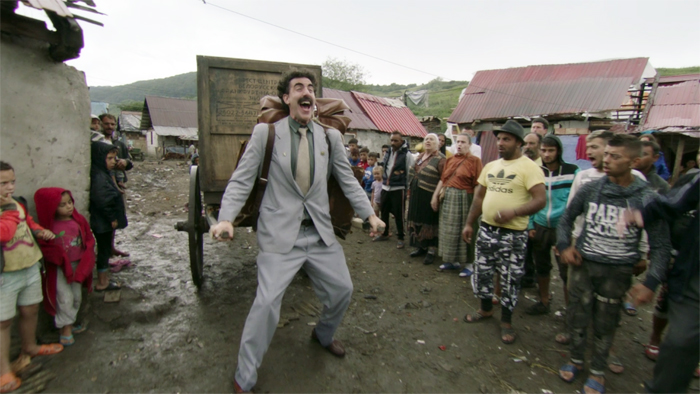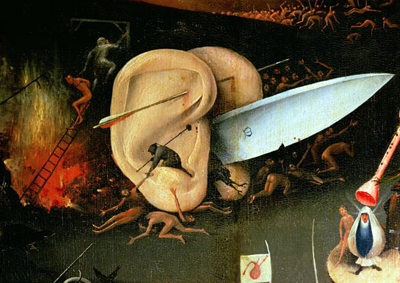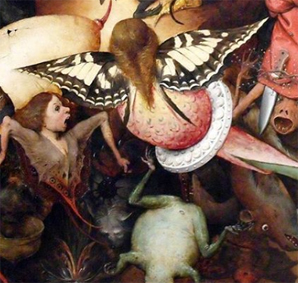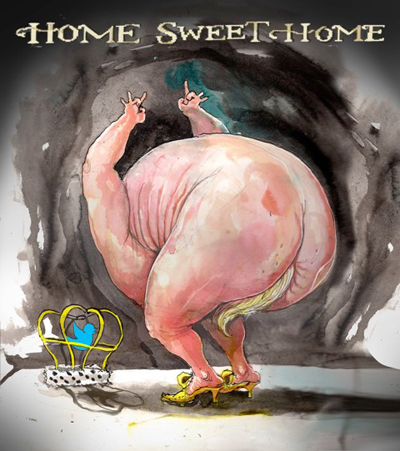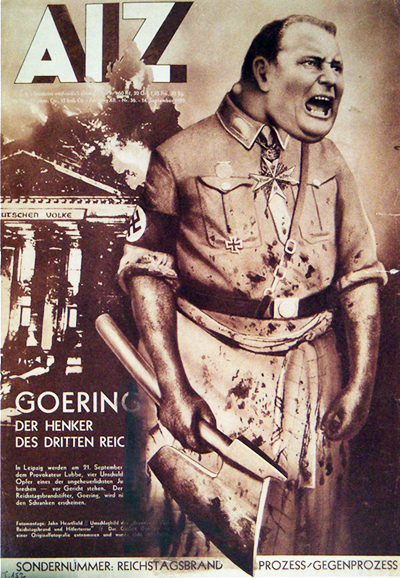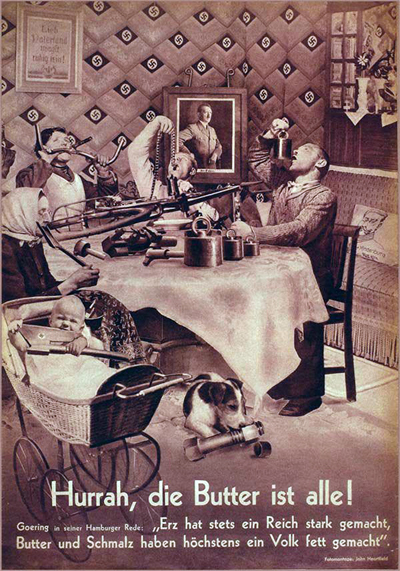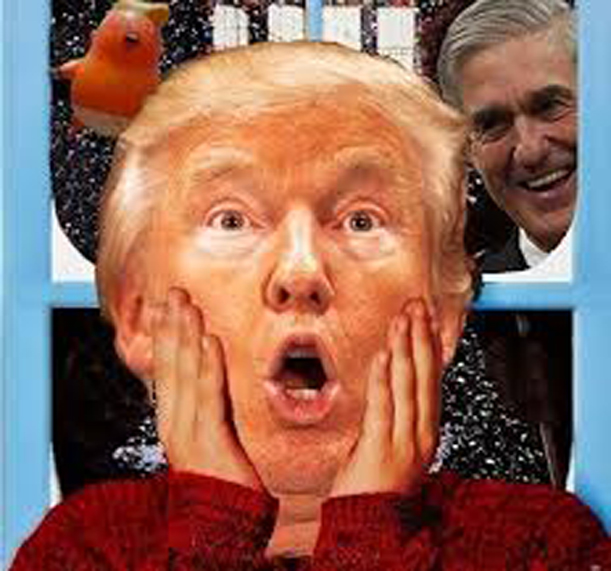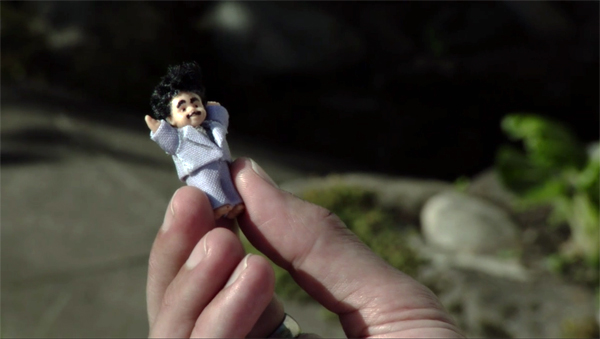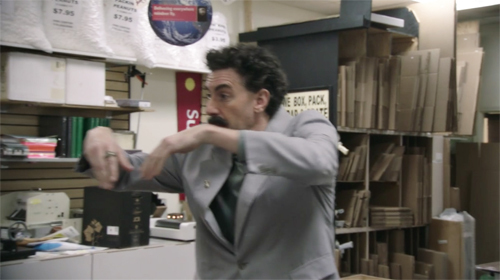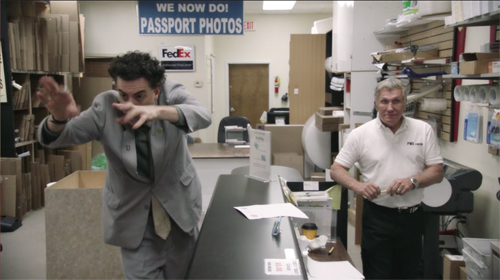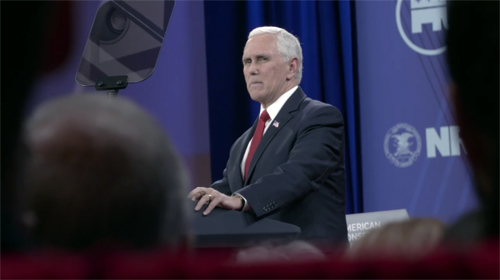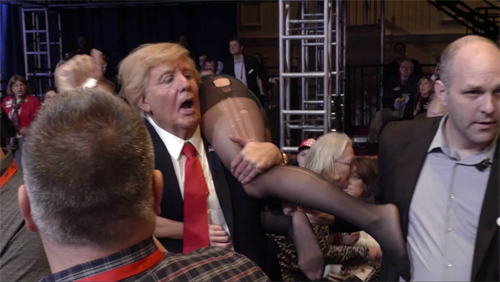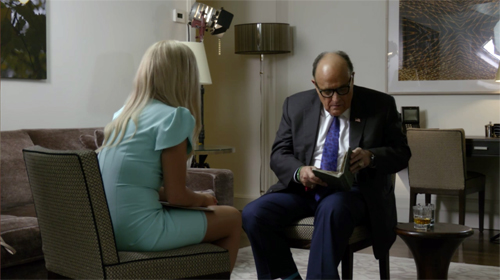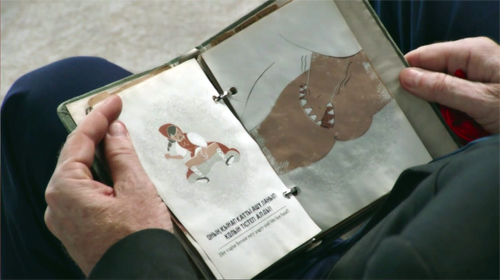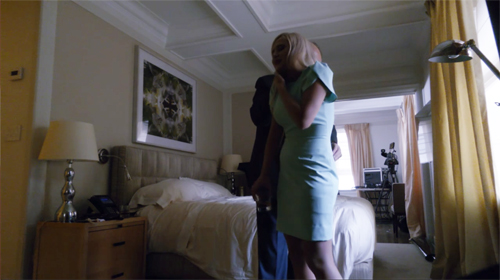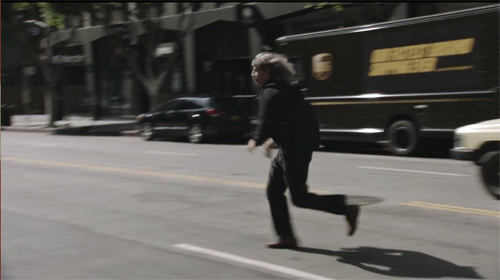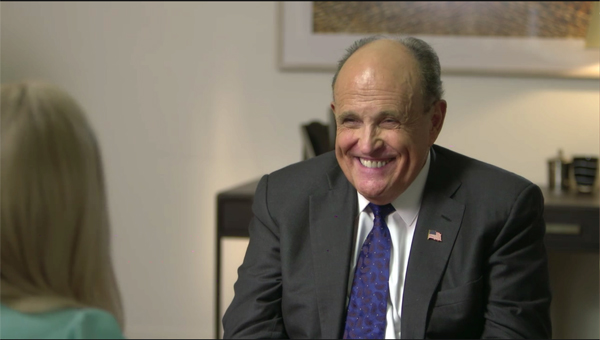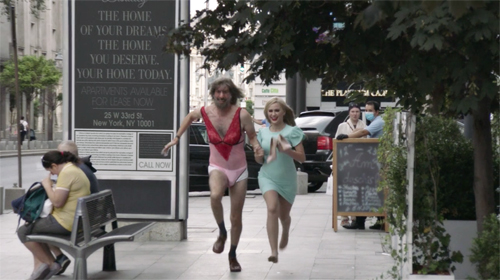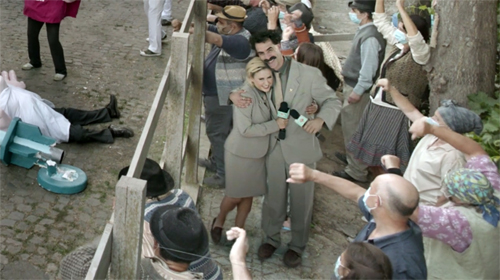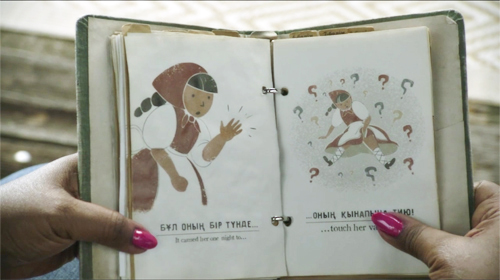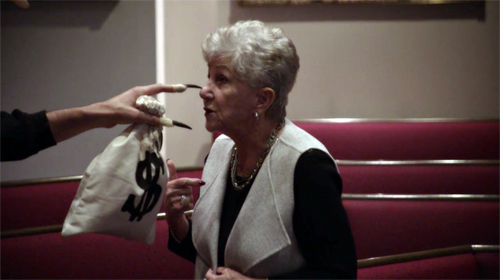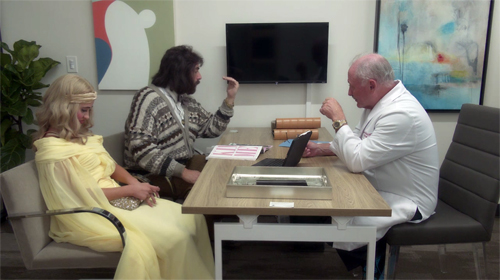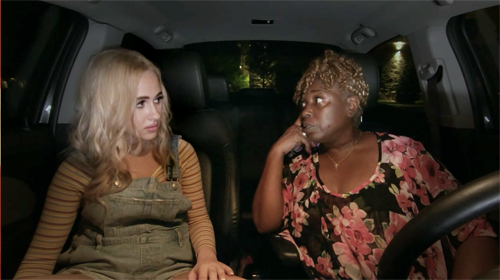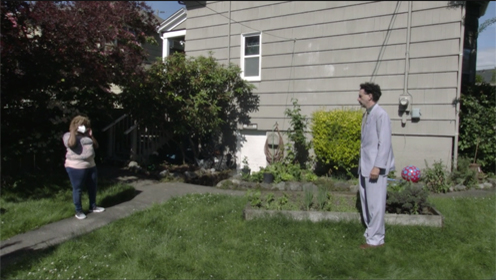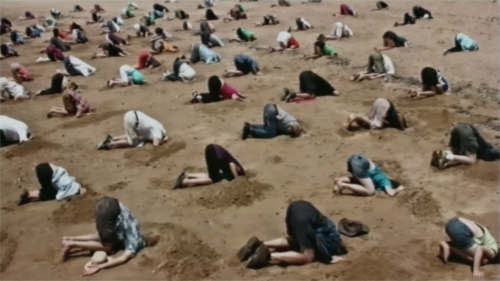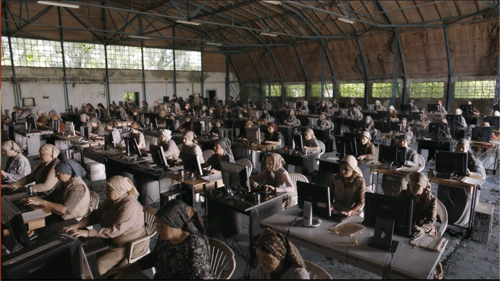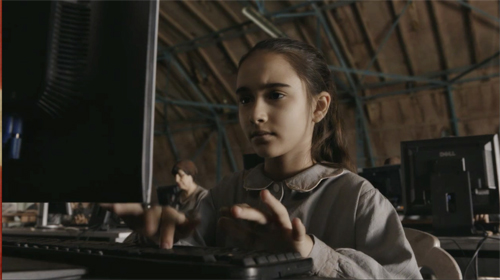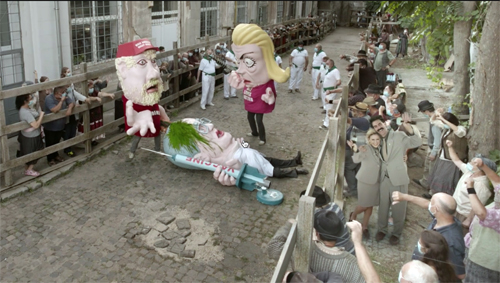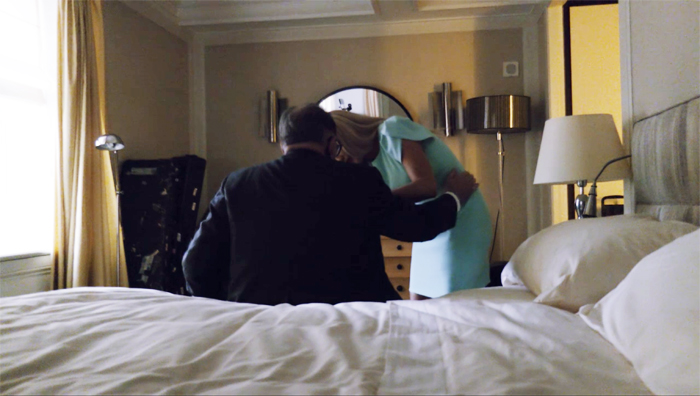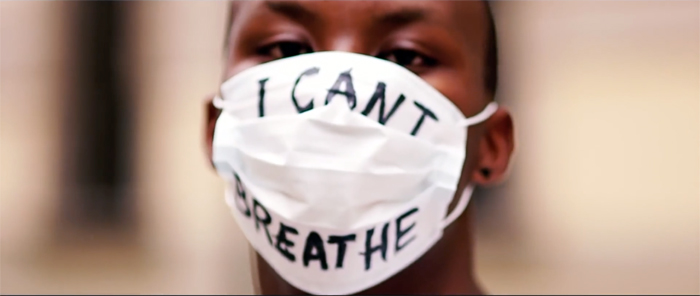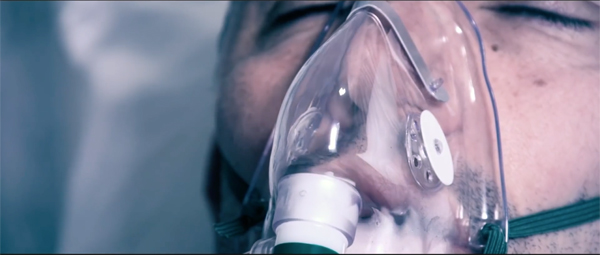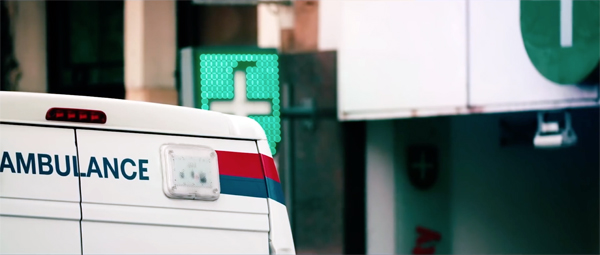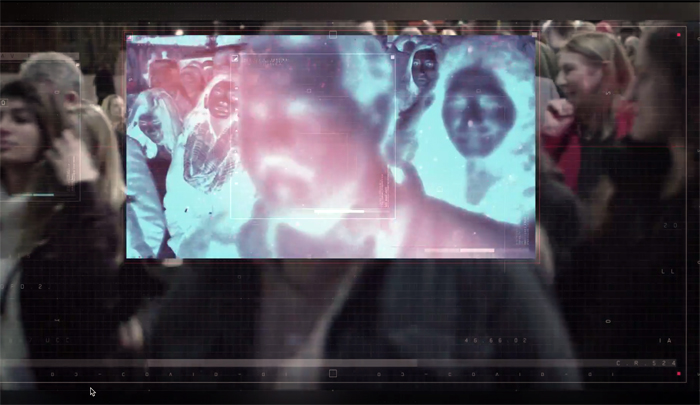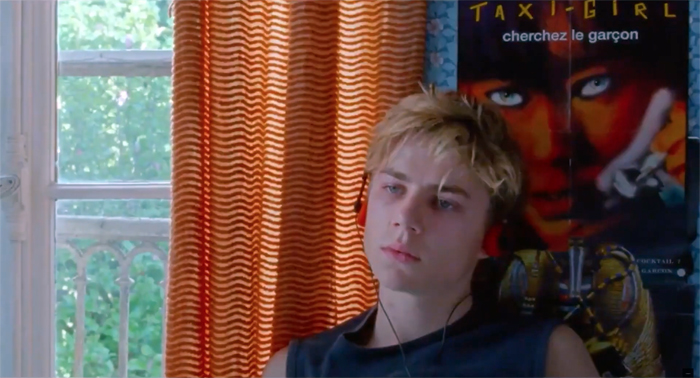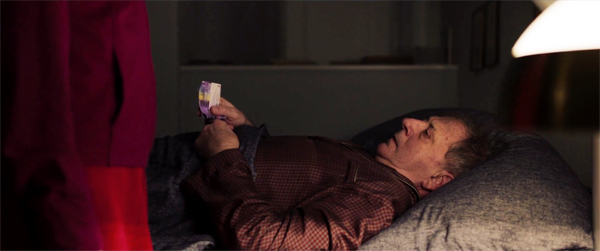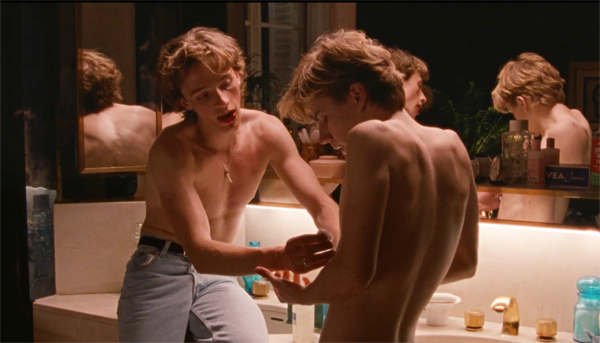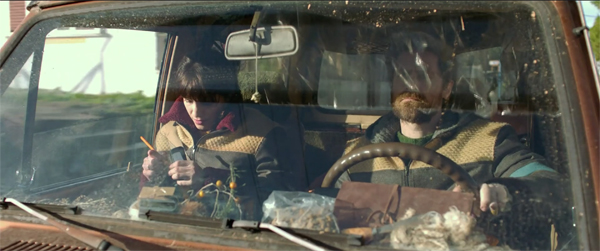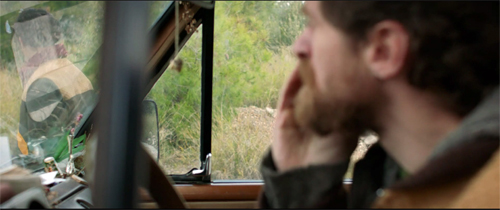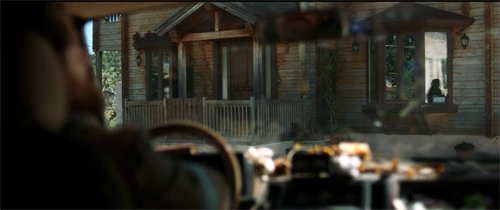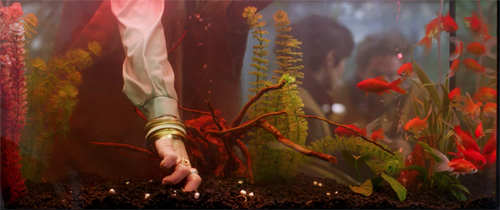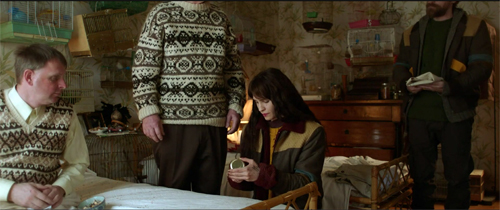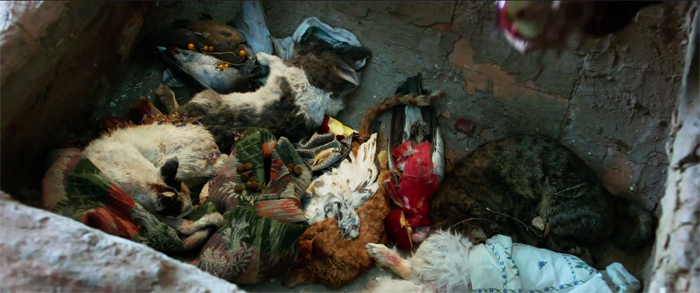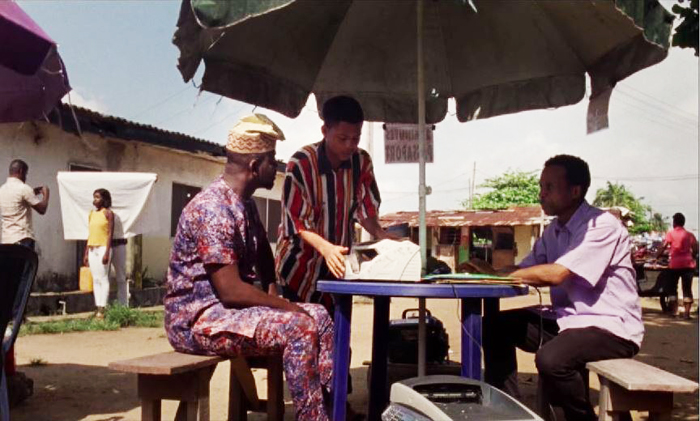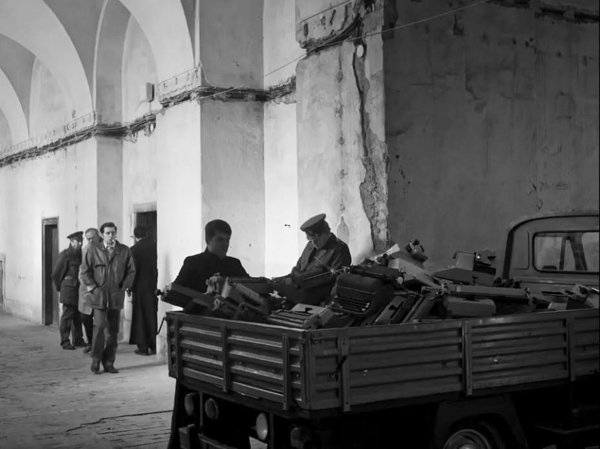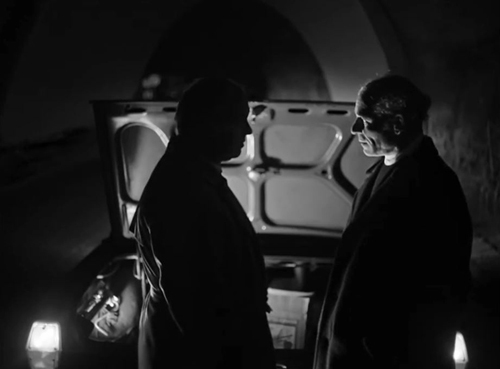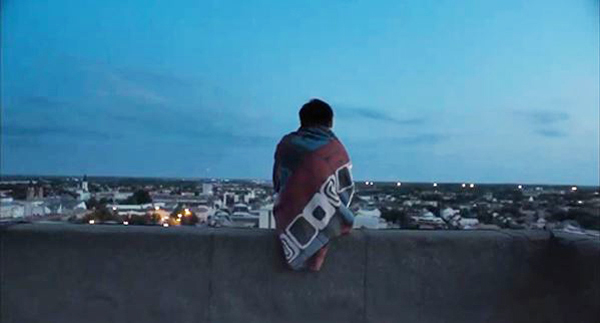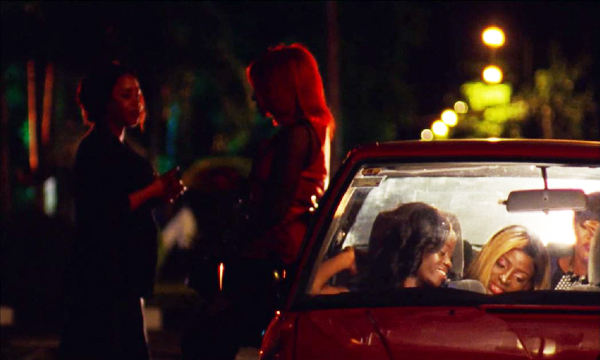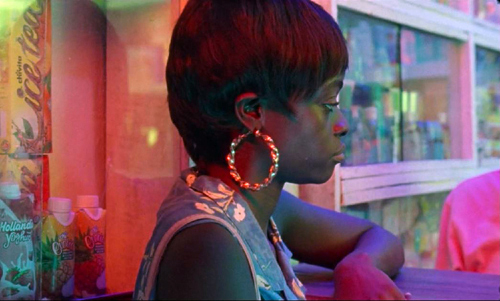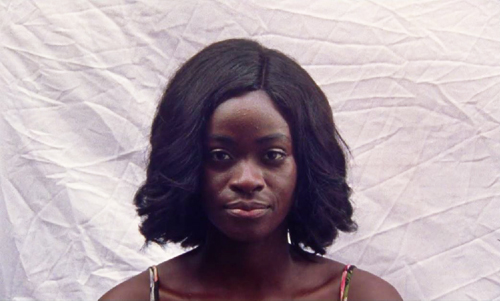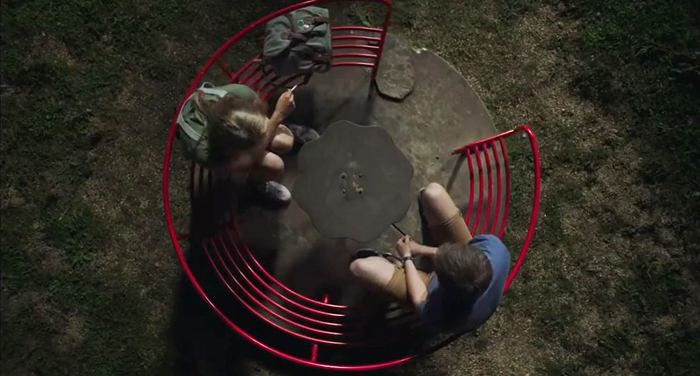Archive for the 'Film comments' Category
Borat: Keep it stupid, simple
Borat Subsequent Moviefilm: Delivery of Prodigious Bribe to American Regime for Make Benefit Once Glorious Nation of Kazakhstan (2020).
DB here:
Defending some of his wildest films, Hong Kong director Tsui Hark pointed out: “Sometimes it’s fun to be stupid.” True enough. But we need to be stupid in sync. When a leader is being stupid and only some of our fellow citizens are, it’s a lot less fun.
The situation invites you to respond with meta-stupidity: Showing how invincibly stupid others are being by doing something stupid yourself. One option is silly satire (Saturday Night Live), but there’s a more deeply disturbing alternative. You can be stupid in a savage, no-holds-barred way.
This can disturb your audience. Shock defeats geniality, obliterates wit. You get called heavy-handed, on-the-nose, over-the-top, and other hyphenated things. You may even move into the realm of the grotesque.
Blunt, tasteless, outrageous grotesquerie has been an important artistic strategy through the millennia. Bosch (below), Bruegel (next), Goya, and other artists have taken exquisite pains to present giddy images of human folly, bursting the limits of taste and sense.
Unsurprisingly, in America the grotesque flourished during the 1960s, in Robert Crumb comix and Paul Krassner’s Disney orgy. Nowadays, Australia’s David Rowe has done fastidious work with slack jaws, skin blotches, and, inevitably, flab.
The realm of the stupid grotesque is one that Sacha Baron Cohen has made particularly his own. It suits our moment.
Friction between parts
The Republican Party’s steamrolling takeover of civil society, begun in earnest in the 1980s but turbocharged under Trump, has created a Golden Age of American agitprop. Responding to the lava flows of vile, vacuous sludge on social media, carefully crafted counterstrikes have shown a fair bit of wit. Call it the spontaneous genius of the American people. That usually comes down to jaunty disrespect.
Caricature is the go-to format for those who can draw. But it’s striking that the photomontage techniques of John Heartfield, aimed at an earlier Reich, have been revived for the Age of Trump. Below, Heartfield’s 1933 portrait of Goering as butcher of the Reischstag, alongside an ailing Trump.
Photoshop makes the craft of photomontage easier than in earlier eras, but the trick is still to have an ingenious idea–a play on words, or a reference to a meme. Heartfield’s famous “Hurrah, the Butter’s All Gone!” defiles the guns-vs.-butter motto of classical economics by suggesting that we’re foolish enough to think we can survive on instruments of death. It also quotes Goering’s speech: “Iron has always made an empire strong, butter and lard have, at best, made a people fat.” While suggesting that Hitler’s followers have a hearty appetite for self-destruction, Heartfield has shrewdly created metaphors: handlebars like a corncob, a bandolier like spaghetti, a bomb like a coffeepot, a grenade serving as a doggy’s bone. The baby teething on an axe-blade is a bonus, as are the sprightly swastikas in the wallpaper.
In the gentler example, Trump isn’t just any baby, he’s the kid in Home Alone (covert reference to his cameo in the sequel), with the invaders as both the Blump and, for once, a smiling Bob Mueller.
Note that these aren’t deepfakes, undetectable blends. Montage promotes friction between parts. The juxtaposition bears the traces of the act of bringing disparate pieces together. (Trump’s hands are plausibly small, but that icebag is an awkward fit.) The pieces create a coherent spatial layout, but there’s enough mismatch to remind you of the act of assemblage.
Of course montage is also a film technique, and sometimes–as with the Soviet films of the 1920s, or found-footage films like those by Bruce Conner–we sense a jolt or abrasion between shots. By and large, though, a film like Borat Subsequent Moviefilm: Delivery of Prodigious Bribe to American Regime for Make Benefit Once Glorious Nation of Kazakhstan is less an exercise in montage (despite all its jump cuts) than a faux-documentary mixing the casual norms of prosumer video and quickie tabloid-crime cable fodder.
Instead of the relatively softball treatment of POTUS seen in my images, Borat Subsequent Moviefilm gives us something much closer to Heartfield’s blood and bombs. As in a photomontage, bits of reality are turned into a cartoon that’s outrageous, even offensive. But like Heartfield, Baron Cohen reminds us of one crucial point. Fascism promises to make stupidity fun.
Just another movie?
Spoilers ahead, of course.
The grotesque is usually associated with deformation, but Borat Subsequent Moviefilm has a firm structure. At the risk of sounding silly, I insist that it’s a surprisingly tightly-knit classically conceived film.
The hero starts off with a goal. Ex-journalist Borat Margaret Sagdiyev will get a reprieve from penal labor if he will deliver Johnny the Monkey as a bribe to well-known “pussy hound” Mike Pence. Borat’s daughter Tutar joins Borat in the US by smuggling herself into Johnny’s cargo crate, and because she has eaten Johnny, she must replace him as Pence’s bride.
The film falls into the familiar four parts. The setup introduces Borat’s goal and peaks at the invasion of CPAC. As usual, the development section that follows redefines the initial goal. Turned away by Pence’s guards, Borat gets his boss’s permission to offer Tutar to Rudy Giuliani instead. This goal forms the through-line for the rest of the film, as Borat undertakes to make over Tutar into a submissive American woman.
The third section is occupied with various delays and stretches of character change. Tutar starts to liberate herself from Kazach patriarchy and Borat comes to accept his daughter as a person. At the climax, when Tutar decides to offer herself to Giuliani to save her father, he races to rescue her–prepared to sacrifice himself to save her from violation. The epilogue celebrates a new stability with a happy ending, if a worldwide pandemic counts.
The main thread is the familiar device of the naive traveler, the alien who reminds us of how strange our everyday world can seem to an outsider. Borat is introduced to smartphones (though he never figures out the camera), cyberporn, plastic surgery, QAnon, and Covid-19. Tutar learns that her vagina will not chomp her arm, that women can drive cars, and that fathers can walk hand in hand with their daughters.
As in a traditional film recurring motifs–raw onions, a chocolate cake, a plastic baby, strings in the brain–bind the scenes together. Stylistically, the apparently offhand shooting displays classic camera ubiquity. We always have the best view because multiple setups are covering the action (something not common in a true documentary), and probably scenes are retaken. Matches on action are the giveaway.
Many of the scenes, particularly those involving crowds at right-wing events, are made to cohere through the Kuleshov effect. Editing allows Pence to appear to react (stonily) to Borat’s appearance in a Trump fatsuit at the back of the hall.
Think Rudy really inspected these pages of Tutar’s book? He is very moved by receiving it.
And there’s a nice homage to Griffith-style crosscutting, when Borat scrambles to rescue Tutar from the clutches of America’s Mayor.
I grant that Borat Subsequent Moviefilm seems pretty episodic when you watch it, but I suspect that’s partly because of the inherent looseness of a road-movie plot, and partly because of the shock effect of individual scenes. That shock depends, I think, on the relentless grotesquerie on display. Classical clarity of presentation enables the film to chart two major types of stupidity at large in our world.
Leering in bestial degradation
The aesthetic of the grotesque centers on fanciful but disturbing deformation, an exaggeration that’s at once playful and threatening. Art critic John Ruskin, describing the carved heads he found on the Bridge of Sighs in Venice, was appalled to see them “leering in bestial degradation.” That’s not a bad description of Borat Subsequent Moviefilm. The operative word, of course, is leering. The grotesque, as James Naremore points out, mixes fear, disgust, and laughter.
The grotesque breaks categories. Borat’s main disguises as a spare-tired redneck make him implausibly cartoonish. Animals become human (Johnny the chimp is a porn star) and humans become animals, or simply raw material. The producer of Borat’s previous film has been turned into an armchair, with privates preserved.
Species transmogrify. Borat himself–hugely tall, loping like a moose, shitting in front of Trump Tower, with his inane grin and wobbly vocal pitches, high-fiving with hands like seal flippers–is a walking graffito, something you might see scrawled on a remote East European grotto. Tutar, like all Kazakh daughters, is kept in a cage. Grotesque art also breaks taboos. The film wallows in menstruation, incest, masturbation, animated POTUS erections, kinky birth stories, and sex toys, including a gag that pivots on Borat’s accent (Amazon delivers “fleshlights” instead of flashlights). In this context, Rudy Giuliani’s 1200-watt smile becomes wolfishly sinister.
Again, though, narrative processes provide some development. Tutar abandons her cage and (in a sign that Borat is warming to her) joins her dad in the trailer. She becomes a high-gloss Fox-babe interviewer. Borat correspondingly submits to a gender revision, showing up in a bikini to save her from Giuliani. The armor-plated gender roles assigned by Kazakh culture melt a bit in Borat’s odyssey, though again–faithful to the grotesque–father and daughter’s final slow-mo romp through Washington streets is less a lyrical reconciliation after two “character arcs” complete than another bit of tawdry public cosplay.
Eisenstein thought that the grotesque had two registers, the comic (say, slapstick) and the pathetic (say, The Hunchback of Notre Dame). So you could argue that the Borat film moves broadly from the first to settle on the second. In the very last scene, there’s even a hug as a “normalized” Tutar and Borat assume meritocratic professional identities.
Still, this normalization doesn’t really wipe away a cruel Boschian vision of a hellscape seething with grotesques. The film sets up two parallel cultures, Kazakhstan and the USA, each deeply committed to imposing stupidity on its populace.
Kazakhstan is a parody of traditional folk patriarchy as recast by a Communist state. Fathers treat daughters as livestock while corrupt officials execute their enemies. Social life is ruled by a guidebook that Tutar dutifully carries everywhere. It details all the powers due to men and all the roles allotted to women, with special instructions about areas they must not touch.
The USA, for all its wealth, is filled almost completely with deadpan imbeciles who advise Borat on how to cage his daughter and gas gypsies. Women instruct Tutar in finding a sugar daddy and behaving at a debs’ ball. True, Tutar learns that the Kazakh manual is bunk, but her new vessel of truth is Facebook, which assures her that the Holocaust didn’t happen.
Armed only with a barbaric yawp, Borat visits anonymous malls and bland bakeries. This moronic inferno houses the pious women of a Republican club, the well-heeled attenders of a CPAC meeting, and Gadsden flag-wavers. As the virus spikes, Borat takes refuge with conspiracy theorists who claim that the Clintons drain children’s adrenaline and feast on blood. Crashing a Second Amendment rally, Borat can quickly teach the audience a song which urges that members of the press be chopped up “like the Saudis do.”
Does an elderly Jewish woman provide a glint of light? After all, she assures Borat that the Holocaust really happened. But the twist is that he’s comforted because her news vindicates his countrymen’s historic role working in the camps. And the image remains pure grotesquerie: a Nosferatu-like Borat measures the lady’s nose, in an echo of the visit to the obliging plastic surgeon who discusses Jewish noses.
If the Kazakhs have been regimented in the service of the state, the American social default is freewheeling, blank indifference. You can tell someone you’re chaining up your daughter, you can send a penis image by fax, you can walk into a conservative gathering in KKK robes, and at best people raise an eyebrow. Stupidity is stolidity. Behind every reaction shot is the unspoken American version of tolerance: Whatever.
The French call us les grands enfants, the big kids. In a country where you do whatever you want until somebody says you can’t (and then you will demand to do it as an expression of freedom), why shouldn’t a man suggest paying for breast implants by letting perverts watch the procedure? (“The perverts,” the staff member explains, “have to be medical personnel.”) Why shouldn’t a birth counselor overlook the father’s apparent confession of impregnating his daughter? You want “Jews will not replace us” squiggled on a cake, with a happy face underneath? No problem. Why shouldn’t the President’s personal lawyer claim on the record that the Chinese invented the virus and deliberately unleashed it on the world? Maybe. Might be something to that. I’m just saying. Check out the retweet.
The most redemptive moments come with Jeanise Jones. As Tutar’s babysitter she nudges the girl away from having breast implants and sets her on the way to thinking independently. Jeanise also teaches Borat that the pain he feels in his heart is love for Tutar. Another way this is a classical movie: Borat Subsequent Moviefilm has its own Magic Negro.
Narrative being narrative, the climax brings a change. Borat returns home, expecting execution, but he learns that his mission has actually been accomplished. His real purpose was to spread the coronavirus, developed in Kazakh labs to punish the world for laughing at the homeland after his first film. He has been the Typhoid Mary of the pandemic (his middle name is Margaret), and with his success Kazakhstan recovers a place of honor in the world community. It has moved forward to the digital age. Instead of playing ostrich, cut off from the outside world, the people are now staffing troll farms.
Now the daughters have joined globalization and have something important to do: overturn American democracy.
And instead of the Running of the Jew, the honorable tradition revealed in the first film, the homeland can afford to look down on a new scapegoat: America. In a colossal magnification of the grotesque, the ballcap hillbilly and the gun-toting Karen terminate Dr. Fauci.
Satire gone gross, pranks and punking pushed to randy delirium: No wonder Sacha Baron Cohen was so suitable for the role of the Yippie Abbie Hoffman in The Trial of the Chicago 7. In Borat Subsequent Moviefilm, I think he has done something important. He has made the 1960s put-on a vehicle of political criticism, by simply demonstrating how scary the pleasures of being stupid can be.
The movie cons its subjects, people say. No, they con themselves, aided by the Whatever principle. It’s not always very amusing, detractors say. Right. The grotesque never is. Being thoroughly stupid isn’t thoroughly fun. We are going to learn this over and over in the days and years ahead.
For enlightening commentary on Heartfield, visit here. On comix, the authoritative source is James P. Danky, Underground Classics: The Transformation of Comics into Comix (Abrams, 2009).
The standard survey of the grotesque is Wolfgang Kayser’s The Grotesque in Art and Literature. Jim Naremore makes the case for Stanley Kubrick as an artist of the grotesque in On Kubrick (British Film Institute, 2007). My quotation from Ruskin comes from p. 26 of that.
On the camera-ubiquity convention of pseudo-documentary, as it bears on The Office, you can see this entry. There’s also this one, on the Paranormal Activity series. The Kuleshov effect is discussed throughout our entries, especially here and in this video.
A noun, a verb, and . . . copping a feel in Borat Subsequent Moviefilm.
Little stabs at happiness 6: Breathe
Commander in Chief (2020).
Last summer, in hope of reviving spirits in these times, I ran a series of clips I admired for their ability to arouse and energize. They created a sort of disciplined exhilaration through adroit editing, camerawork, and music. They reliably gave me a lift, and maybe you too.
Now, in the Caligula phase of Trump’s presidency, it seems appropriate to pay my respects to a masterpiece of engaging agitprop. I’ve registered my reservations about the Lincoln Project in an earlier entry, but there’s no denying that these walking wounded of right-wing partisanship have recruited some very talented filmmakers. Their “Covita” assemblage was superb, and they have outdone themselves with this morning’s triumph.
Here it is:
Experience it–but then we should study it.
It’s an excellent example of what we call in Film Art associational form–a blending of images, sounds, and texts to imply ideas and provoke feelings, in the manner of lyric poetry. The text itself is a lyric poem, at once ode, elegy, and apostrophe. Demi Lovato’s choked, rising and falling vibrato is in itself powerfully expressive. Just as important, the audiovisual texture enriches the text. Sometimes it’s a matter of the image echoing the words, and sometimes the associations are purely visual. An element in one shot, such as a gesture or facial expression, will call up something similar, or a contrast.
The effects flash by quickly. Taken just as images, what do these shots have in common?
Nothing but a pulse: Labored breathing on a ventilator matches the flicker of an emergency vehicle’s turn signal, as if life is running out before our eyes..
The structure mimics the song’s layout. We move from problem to solution, from crisis to resistance, from emptiness to crowds, ending on a resolution that puts action in the hands of the viewer. Threading it all together is the way “I can’t breathe” gets redefined. The phrase shifts from being associated with George Floyd and other victims of police atrocities, to the COVID-19 pandemic, before adding a twist: Trump’s own bout with the virus, capped in a direct address to him. How does it feel to be able to breathe? By the end breathing becomes metaphorically linked to voting. How does that feel?
As I mentioned in that earlier entry, contemporary agitprop reminds us how much every filmmaker owes to traditions. The techniques used in Commander in Chief stretch far back into the history of cinema; the upraised fists of the finale could have come straight out of Soviet montage.
It might seem pedantic to talk this way about such a powerful piece of cinema. But the point is that the things we study are really out there, crafted by creative filmmakers and having an impact on viewers. The art we care about has concrete effects, and in studying it we can clarify just how those effects are achieved. Analyzing forms and styles can broaden our sense of what cinema can do, and it can strengthen our respect for the filmmakers who explore it.
A similar analysis could be undertaken with many of the best current polemical documentaries, like Unfit and Totally Under Control. These galvanize us not just through their subjects and “messages” but through their fresh use of conventions of form and style. (The sequences of Totally Under Control devoted to First Capon Jared Kushner will remain models of satiric montage.) As with the best of Adam Curtis’s work, these are important contributions not just to political discourse but to the history of film as an art form.
Those goosebumps, that quivering gut, those tears? They come from cinema, grand synthesis of the arts.
Another documentary working in this vein, Leo Hurwitz’s Strange Victory, is discussed here. It’s completely appropriate to our current crisis.
For other reflections on the Trump coup attempt, go here and here and here and here.
P.S. 9 December 2020: After winning an Advertising Age award for the Lincoln Project campaign videos, Rick Wilson explains the strategy and assesses their success in the first of four parts.
P.P.S. 24 December 2020: More backstory on the making of these videos from producer/director Ben Howe.
Totally Under Control (2020).
Vancouver envoi: What happens in movies happens between your ears
Summer 85 (2020).
DB here:
One of the nicest things anybody ever said to me came from Jacques Aumont, the distinguished French film scholar. He was visiting us in the early 1980s and I showed him a book manuscript I had just sent to the publisher. He read the first three chapters and said, “You remind us of something important. The spectator is thinking.” The book eventually came out as Narration in the Fiction Film.
In emphasizing that the spectator thinks, at least a little, I was driven to pay special attention to openings. The opening is where a film sets up information about its story world, about the action that will take place in it. We usually call this exposition. But a film also attunes us to the how as well as the what: how the story will be told. Exposition, in other words, includes introducing us to the characters and their situation but also to the ways we’ll learn about them. In the book I called the latter the “intrinsic norms” of narration.
But exposition isn’t simply a part of the plot, a chunk of opening material we need to digest. Exposition, the narrative theorist Meir Sternberg shows, is a process. In revealing what we call “backstory,” circumstances that predate the first scenes we see, exposition can go on throughout a film. (Kristin talks about this in her entry on Inception, and in revised form in our Nolan book.) So it turns out that the spectator has to keep thinking, keep reevaluating what’s being told about the story world and the way the story is told.
Three films showcased at the Vancouver International Film Festival set me thinking about these matters. Two depended on surprises, and these stemmed from the way exposition was handled. The third had very sparse exposition, asking us to gradually fill in story background through drifts and whiffs of information. In all cases, our enjoyment depends on thinking.
Surprise!
Bettina Oberli’s My Wonderful Wanda updates the ingredients of classic bourgeois comedy for the modern world of migratory caregivers. Josef and Elsa Wegmeister-Gloor oversee their pampered and confused son and daughter. Into the household comes a servant who is exploited for sexual favors by the old man. Wanda, the nurse brought in from Poland, is today’s equivalent of the chambermaid lusted after by both father and son.
As in most domestic comedies of class relations, Wanda the worker is no fool. Her duties help support her father, mother, and sons back home, and she proves herself a shrewd negotiator from the start. When Elsa asks her to perform extra chores, she demands more money. And when Elsa’s stroke-felled husband is willing to pay for sex, she agrees. Their secret bargain will, in good farce fashion, come to light in the most embarrassing way possible.
I went into the film knowing much less of the plot than I’ve just told you, so I want to keep back the rest. (Alas, the trailer overshares.) I was able to appreciate the way that Oberli’s tight script kept the surprises coming. Her script finds an admirable balance between clear structure and unpredictable turns.
Here the exposition is, in Sternberg’s terms, mostly concentrated and preliminary. The early scenes fill us in on the basic situation. Wanda is among several women met at the bus by Elsa. This is a compact way to suggest how much this class depends on the arrival of emigrant labor. Wanda is then taken to the family’s sumptuous villa. We learn about the situation as she does, and this introductory stretch culminates in Wanda’s introduction to her cramped basement room. In good traditional fashion, the exposition quickly encourages us to sympathize with the protagonist by showing her treated unfairly. On the basis of the information we get, the film’s first “act” becomes a tensely rising action in which Wanda becomes victimized by the petty conflicts that wrack the family.
A second long section begins in a lighter key, with the dismissed Wanda returning after some months, in a scene parallel to the opening. This chunk provides another concentrated dose of information, bringing us up to date on the family’s situation. Comic complications emerge when the family has to cope with a new, more pressing set of demands.
In good Renoirian fashion, Oberli gives everyone a dose of sympathy. The frailties of the son and daughter get nuanced and softened, and we see this coddled pair as less selfish than self-destructive. The action tapers into cringe comedy (drunken embarrassment) and farce (an errant cow), but it’s steered by carefully modulated character revelation, particularly on the part of Elsa, who is played by an indominatable Marthe Keller.
My Wonderful Wanda keeps surprising you to the very end; it trains us not to take everything for granted. There’s even a classic theatrical denouement, itself twisty, which is undercut by a final shot of GOFAC (Good Old-Fashioned Art Cinema) uncertainty. Yet after each reversal, you think it had to be that way. What happens later is consistent with the exposition we’ve built up.
Surprise, postponed
Concentrated exposition, gathered in an opening or elsewhere, sets our expectations, so new story information can modify or revise them. For instance, when Wanda is summoned late at night to Gunther’s bedside, I assumed he needed meds or some help going to the toilet. The expository scenes had set her up as a traditional caregiver. So I was surprised when she mechanically slipped into what became clear was a sexual routine. That prompted me to recalibrate my sense of their relationship, and it made me aware of the limits of what I’d assumed.
Which is to say that exposition as a process is usually partial. We don’t get everything in the backstory at once, and sometimes what’s suppressed is central (as in My Wonderful Wanda). A more extreme example is François Ozon’s Summer 85 (Été 85). Here the expository information is distributed much more widely across the film. We get the backstory only gradually and piecemeal. Because some important information is withheld, the film nudges us toward certain expectations that need to be adjusted.
Again, I have to be careful about spoilers, so let me talk generally. In the book that I mentioned and for many years since, I’ve written a lot about flashbacks. One common schema for flashbacks is the crisis structure. The plot starts near a story’s climax and then suspends the outcome in order to shift back into the past and show how the crisis came about. The crisis structure can provide a film’s overall intrinsic norm of narration, so we expect that this pattern will carry through from scene to scene.
Ozon, another elegant storyteller, knows we have learned the crisis structure. When the opening of Summer 85 shows the teenager Alex dragged into a corridor and then interviewed by police authorities, we’re encouraged to summon up our experience of other movies. A crime has been committed, and he’s either a witness or a suspect. Ozon sets up a familiar to-and-fro pattern between past and present, an investigation and the mysterious crime leading up to it.
The distributed exposition provides flashbacks that take us chronologically through the events leading up to the night of the arrest. Alex is drawn into a love affair with David, a charismatic older boy. With his mother David runs a shop on the beach. She is slightly scatterbrained and seems unaware of their passions, while Alex’s parents are likewise in the dark (and surely disapproving). When the English au pair Kate shows up on the beach, Alex fears David will abandon him, and we expect that a classic romantic triangle will drive the film forward.
Except that’s not quite what happens. As Alex’s jealousy deepens, we might expect a sort of Patricia Highsmith crime to ensue. Instead, Ozon dares to go with a less brutal but more plausible turn of events–one that makes us reevaluate why Alex is being investigated, and what his actual crime is. By distributing exposition slowly across the whole film, Ozon not only creates a lot of curiosity about what has actually happened, he’s able to arouse expectations that will get challenged by new revelations. He exploits the how of narration to modify our understanding of what has occurred–and, it turns out, why.
I’m sorry to be so cryptic, but I face the reviewer’s dilemma of not giving away plot twists that should take you by surprise. Here, though, the surprises aren’t short and sharp, as in My Wonderful Wanda. They unfold more gradually and allow you time to think–about the characters and their motivations, and about what you took for granted might have happened. You might even feel a bit ashamed for misjudging Alex, who turns out to be loyal and forgiving in ways we might call unexpected. Yes, dancing is involved.
Surprise?
My Wonderful Wanda has a straightforward arc of conflict and resolution. Summer 85 is more nonlinear, skipping to and fro through time, but it too can be plotted as a drama of tension and release. What then to say about Kala Azar? It’s another film that teaches us how to watch it, and how to think through it. But it seems to lack those traditional patterns of coherence.
Or rather, it has other patterns. Instead of a drama of conflict and change, it explores a situation built out of routines, gradually revealed and eventually varied. This is another plot strategy, one familiar from “art cinema.” It builds a mystery into not only the story action but into the way the story is told. What is going on? And why am I told about it in this way?
Start with the title. It refers to a severe infectious disease spread to animals and humans by sandflies. It’s currently raging as a pandemic in over seventy countries. But the film Kala Azar is less about the disease (although we spot some lesions on characters who might be infected) than about the relations of humans and animals–specifically, some marginal Greeks scrounging a living on the outskirts of a city, along with the dogs, cats, and other creatures that wander into their lives.
There are three strands of action, each with its own routines. Most prominent are the couple, a young man and woman working for a service that cremates household pets. The couple live mostly on the road in their van, gathering pet remains from households and bringing them back to a central facility. They then return the ashes (not always scrupulously preserved, it seems) to the waiting owners. Another couple, the woman’s father and mother, keep stray dogs in their house. A third line of action involves Orguz, a migrant worker glimpsed from time to time at a chicken farm nearby.
The central couple have started adding roadkill to their cargo, as if believing that these creatures too deserve a serious farewell to life. And at certain points the story strands meet, although glancingly. In something close to a traditional climax, the young man, provoked by seeing a shooting party, takes a decisive action.
All of what I’ve told you is built up through dozens of short scenes, usually without dialogue. There’s probably more going on here than I’ve been able to grasp on one viewing. But the sparse, widely distributed exposition, and the apparent looseness of the plot challenge us to fill in things as best we can. Just as important, by not providing a traditional dramatic arc, director Janis Rafa encourages us to shift our attention to other aspects of her film.
We’re invited, for instance, to examine shot composition, to explore the landscapes on which the camera dwells, to scrutinize textures and gestures. These items are sometimes seen at one remove, through dirty panes of glass or layers of focus or in slim apertures.
Entire scenes often chop off faces in order to emphasize the contact that the bodies make with their surroundings, or to turn bodies into pure pattern, as when two grieving pet lovers are shown dressed identically.
These visual strategies may seem a bit arty, but I think they build up a tactile sense of the environment of these routines. Rafa has said that she wanted to evoke the “animalistic” quality of the imagery, which isn’t only a matter of a low camera position. The sensuous quality of the vegetation, streams, and roaming dogs comes across strongly. Kala Azar earns its severe gravity through its patient attention to details of a world in which humans and animals interact in very tangible ways. Stray animals meet stray humans, and the visual style registers the encounter with quiet nuance.
From concentrated preliminary exposition, to distributed and elliptical exposition, to what we might call minimal exposition: This continuum shows some creative options available to filmmakers in telling their stories. Each one invites us to build up expectations, to reconsider new information in the light of what we knew (or thought we knew), and to assemble a coherent line of action. In other words, we think. That’s not all we do, but it’s a big part of how we watch movies.
As usual, special thanks to Alan Franey, PoChu AuYeung, Jane Harrison, Curtis Woloschuk, and their colleagues for their help during this reliably exciting festival. This is usually the time of the year when Kristin and I wish we lived in Vancouver, and that feeling is sharpened by the health crisis now engulfing so many countries. Cinema helps keep us civilized.
These and other films we’ve reviewed should be making their way to other festivals, so we hope you have a chance to catch up with them.
For more on the narrative strategies I’ve discussed here, see Meir Sternberg’s magisterial Expositional Modes and Temporal Ordering in Fiction (1978). This is in my view one of the great books in narrative theory.
For more on narratives built on threads of routines, see this earlier entry on Chop Shop and other films at Ebertfest. An entry on editing pursues the between-your-ears theme.
Kala Azar (2020).
Vancouver: Continuing our world tour
Eyimofe (2020)
Kristin here:
Turning back from documentaries to international art cinema, I’m recommending three films, two from Eastern Europe and one from Nigeria.
Servants (2020)
Ivan Ostrochovsky, an established Slovak producer of documentaries, whose first feature Goat (2015) was successful on the festival circuit, has followed it up with a second. Servants showed in the Encounters program at Berlin and earned enthusiastic reviews (Variety, Screen Daily).
The film opens with a flashforward as a body is dumped on a dark country road–a scene that will later be replayed when we have more information as to who the victim is. Suddenly a title, “143 days earlier,” appears, and the plot focuses on two beginning seminary students, Juraj and Michal. Briefly we seem to following their personal stories, but their introduction to the seminary routine serves largely as exposition for us. Signs of Communist repression of Catholicism begin to surface. A defiant note anonymously posted leads to a confiscation of all the students’ typewriters (above) in a search for clues as to its author.
The organization behind the repression is an actual historical agency, “Pacem in Terris,” which spied on and controlled the Catholic Church, from 1971 to the early 1980s. (The film is set in 1980.) Its goal was to seek out any signs of political activity, i.e., rebellion, among the clergy and seminarians. Juraj and eventually Michal join a small clandestine group of students working against Pacem in Terris. They become the targets of a ruthless agent, “Doctor Ivan,” (seen at the right below). He is the man responsible for the body-dumping in the opening.
Servants, impressively shot in black-and-white, has been called a film noir, and it certainly has all the sinister tone, the chiaroscuro lighting, and the ill-fated heroes of that genre, mixed with the trappings of art cinema.
Ivanovsky demonstrates how much suspense and dread can be packed into a mere eighty minutes.
On the Quiet (2019)
Another short feature that packs a lot of drama into its 81 minutes is Hungarian director Zoltán Negy’s first feature, On the Quiet. It deals with the touchy subject of alleged sexual abuse of a minor. The film’s smart script, co-written by Negy, is credited as having been developed at the “My First Script Workshop” of the Zagreb Film Festival. As I have suggested elsewhere, such workshops run by festivals have come to play a major role in making such sophisticated storytelling possible.
The main strength of the script is how it maintains an utterly balanced ambiguity about the allegations at its core. The beginning introduces the protagonist, Dávid, first violinist in a student orchestra in a prestigious music school. The teacher-conductor, Mr. Frigyes, employs eccentric techniques with the players. When Dávid fails to perform his solo part adequately in rehearsal, Frigyes tells the other students to gather round to massage his shoulders. This apparently helps him improve.
Soon Frigyes is giving private lessons to 14-year-old Nóri, a pretty, inexperienced but talented cellist. The first lesson we witness has him relaxing her by having them toss a ball back and forth. He touches her elbow and shoulder to adjust her posture. That is all that we witness. Yet soon Nóri complains to Dávid that the teacher has done “weird” things to her, but she won’t specify except to say they were “intimate.” Disturbed by this, Dávid gives her his phone to secretly record a lesson with Frigyes. The resulting dialogue could equally be the teacher directing the girl’s cello technique or instructions about sexual caresses. Dávid’s girlfriend points out to him that Frigyes uses his touchy-feely approach with all the students, but he persists in trying to discover the truth.
The situation escalates as Dávid informs a female counselor, who interviews Nóri and her mother. The girl denies that anything untoward happened. Still, the gossip spreads and the situation eventually threatens Frigyes’s position at the school. Did he abuse the girl? Did he simply not realize how his hands-on guidance could make the girl uncomfortable? Is she naively over-reacting to teaching methods that don’t seem to bother the other students?
I have seen one review that simply declares that the teacher is a perverted abuser, but the film seems far more subtle to me. Without ever implying that Nóri’s complaints should be dismissed, the film explores the effects of the spreading rumor on all those involved. It does show that no real investigation of the claims, which would be the logical way to proceed, ever takes place. In short, it is a careful presentation of its sensitive subject.
The film is well directed, though far from flashy. It does have the occasional striking shot, as when Dávid ponders the situation one evening (above) or sits talking with Nóri on a playground merry-go-round in an overhead shot (see bottom) that hides their expressions and suggests his confusion.
An interview with Negy about the film suggests that he is a thoughtful as well as a promising director–and one with three more film scripts underway.
Eyimofe (2020)
From the early 1990s, Nigeria has built up a thriving production of low-budget, DIY and professional films. At first distributed on VHS tape and then on digital disk, these have had enormous success at home and among the African diaspora. Kunle Afolayan formed a company that commanded government support and product placement to finance October 1 (2014), which played at film festivals, mostly within Africa. More recently, Kemi Adetiba’s The Wedding Party (2016) premiered at the Toronto International Film Festival, and Kathryn Fasegha’s 2 Weeks in Lagos premiered at the 2019 Cannes festival, where it was somewhat overshadowed by Mati Diop’s Atlantics, playing in competition.
Now comes Eyimofe (This Is My Desire, in English, but much of the coverage on the internet uses the Yoruba title). It is directed by twins crediting themselves as Arie and Chuko, though their family name is Esiri. They have created an formally and stylistically impressive film that gives fascinating insights into the society of the sprawling conurbation of Lagos, an area with an estimated population of 21 million.
Arie Esiri studied Screenwriting and Directing at Columbia University’s School of the Arts, while Chuko Esiri earned an MFA, also in Screenwriting and Directing, from New York University’s Tisch School of the Arts. They wisely shot Eyimofe on 35mm, and the lush visuals exploit the bright colors of Sub-Saharan African clothing (see top of entry) and furnishings. Cinematographer Arseni Khachaturan adds bright colored light, especially at night and in shops, to create a gorgeous look (above and below).
The plot is split into two parts via titles: “Spain” and “Italy.” In each part, the main character is struggling to migrate. Mofe, an electrician, is gradually collecting the documents and money he needs for his move to Spain, where he will adopt the name Sanchez. Rosa, working both as a beautician and cocktail waitress, has similar aspirations to relocate to Italy, taking her younger sister Grace along. Both protagonists must scrape up money to pay for the passport, visa, fake letters promising employment, and other expenses. There are many complications, including a death in Mofe’s family and an unexpected revelation of the lengths to which Rosa and Grace will go to secure their passage.
The two stories are largely separate. There are moments when the characters pass each other briefly, and Grace even chats with Mofe at a little repair stand he sets up. Yet none of these chance encounters involves any causal connections between the two plots.
Early in the film Mofe visits an open-air “office” where a man who specializes in getting passports and visas–for a hefty fee (see top, where Mofe is on the right). In the background we glimpse a woman getting a passport photo taken against a white cloth. Late, near the beginning of the “Italy” section, we meet Rosa, having her passport photo taken in front of a similar backdrop (below). She’s in a different passport shop, however, suggesting that such informal establishments, vital for aspiring emigrants to cut through the red tape and delays of government procedures, are common in Lagos. It’s also the first of several parallels between her story and that of Mofe, clearly intended to suggest how common such struggles to leave for Europe are.
Unlike Mofe, Rosa aspires to a fun, modern social life, buying fancy clothes while sleeping with her landlord (who happens to be Mofe’s landlord as well) and then starting an affair with a wealthy Lebanese-American businessman. Her nightlife offers the occasion for flashy images, including the positively Godardian composition of her in a car with her friends (at the top of this section). As with Mofe, an unexpected death helps derail her plans, and we learn just how far she and Grace had been willing to go in their hopes for a better life abroad.
Eyimofe is a powerful film and well worth seeking out at a festival or on streaming. It’s having its UK premiere at the London Film Festival, which starts tomorrow. For a brief discussion by the directors about the film’s background, financing, and festival life, listen to this BBC radio interview. For a detailed description of the film’s success during its screenings during the Berlin festival from a Nigerian point of view, see here.
As a remarkably rich and successful festival draws toward its end, special thanks to Alan Franey, PoChu AuYeung, Jane Harrison, Curtis Woloschuk, and their colleagues for their help during it.
On the Quiet (2019).












